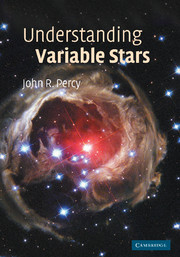Book contents
- Frontmatter
- Contents
- List of Boxes
- List of Figures
- List of Tables
- Preface
- 1 History and development
- 2 Stars
- 3 Variable stars
- 4 Rotating variable stars
- 5 Eclipsing variable stars
- 6 Pulsating variable stars
- 7 Eruptive variable stars
- 8 Pre-main-sequence variable stars
- 9 Miscellaneous variable stars
- 10 Epilogue
- Appendix: Acronyms
- References
- Resources
- Index
8 - Pre-main-sequence variable stars
Published online by Cambridge University Press: 28 October 2009
- Frontmatter
- Contents
- List of Boxes
- List of Figures
- List of Tables
- Preface
- 1 History and development
- 2 Stars
- 3 Variable stars
- 4 Rotating variable stars
- 5 Eclipsing variable stars
- 6 Pulsating variable stars
- 7 Eruptive variable stars
- 8 Pre-main-sequence variable stars
- 9 Miscellaneous variable stars
- 10 Epilogue
- Appendix: Acronyms
- References
- Resources
- Index
Summary
In section 2.19, we outlined what was presently known about star formation, and the early evolution of stars. There are several types of variability which are specifically or predominantly found among young stars. Most or all of these would be found in a given star, such as the sun, at various times in its pre-main-sequence (PMS) lifetime. We must always remember that the universe we see is a snapshot of millions of stars, seen at various random stages of their evolution. The PMS stage lasts only a few million years, so stars spend only a small fraction of their lifetime in it. But every star passes through this stage once.
PMS variables are often called nebular variables, because, being young, they are usually found in or near the nebulae from which stars are born. Or they may be called Orion population because the Orion region is a nearby, active site of star formation. One of the challenges in studying these stars is the fact that they are usually found within clouds of gas and dust, which will obscure or hide them at visible wavelengths. Radio observations have therefore been useful, and new sub-millimeter and mid-IR facilities such as the Atacama Large Millimeter Array and the James Webb Space Telescope, respectively, will be ideally suited for studying star formation.
A PMS star could also be an eclipsing or rotating variable, if it had a close companion, or a spotted surface. It could even be a pulsating variable, if it was located in an instability strip. We shall concentrate here on types of objects, and of variability, which are unique to PMS stars.
- Type
- Chapter
- Information
- Understanding Variable Stars , pp. 278 - 295Publisher: Cambridge University PressPrint publication year: 2007



